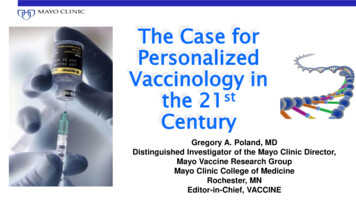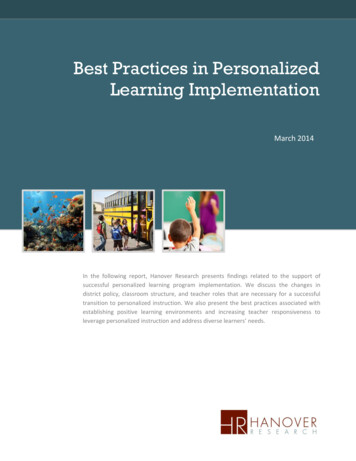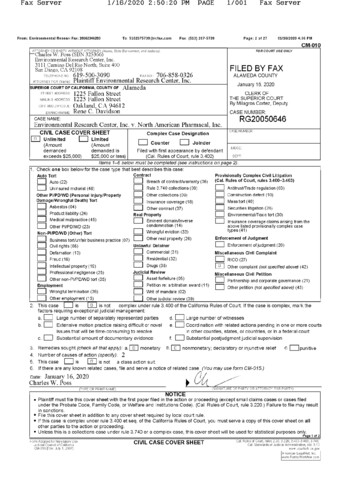
Transcription
The Case forPersonalizedVaccinology inthe 21stCenturyGregory A. Poland, MDDistinguished Investigator of the Mayo Clinic Director,Mayo Vaccine Research GroupMayo Clinic College of MedicineRochester, MNEditor-in-Chief, VACCINE
Background for Change Risk-averse towards vaccines - extremely high levels of safetyrequired The one-size-fits-all approach to vaccination ignores thecomplexity and diversity of the human immune system and hostgenome Increasingly large immunocompromised and elderly populations The promise of vaccinomics and related paradigms is to identifyspecific immune response profiles, immunosignatures, andbiomarkers that predict vaccine safety and/or efficacy, leads tonew vaccine candidates, and allows delivery of the right vaccine,to the right person, at the right dose, at the right time in otherwords personalized vaccinology
Vaccinology 1.0 aTetanusAnthraxCholeraTyphoidOthersInject
Vaccinology 2.0 Subunit vaccines Recombinant technology introduced Newer, but undirected adjuvants Everyone gets every vaccine, same numberof doses and dose amount Still focused on childhood vaccines, fewadult vaccines developed
1940’s – 2000’s One “size” fits all approach Everybody at risk for everything - so give everyoneeverything Prophylactic only Childhood vaccines Adult vaccines Parenteral vaccines dominate (except FluMist and oral typhoid) Very few licensed adjuvants Predicated on a population-level, public health approach
A Vaccine Paradox The goal is to induce protective immuneresponses in (ideally) 100% of the populationwho receive a vaccine We fail at this because of: Pathogen variability Host (human immune system) variability Lack of variability in how we deliver vaccines to thepopulation, i.e. a “one size fits all” populationapproach, and limited paradigms for vaccinediscovery
Vaccine Errors In Thinking Smallpox vaccine – dangerous, too revolutionary, simply notpossible Too hard/expensive to make QIV Not possible to make a Mening B vaccine One dose of measles vaccine is sufficient Rubella vaccine only needed for females HPV vaccine only needed for females Not possible to make 23-valent Pneum vaccines Not possible to give so many vaccines to infants Too dangerous to give vaccines to pregnant women Many, many others
Tomorrow – More Clever? Personalized approach Tiered risk and vaccination approach Prophylactic and therapeutic Adult vaccines Childhood vaccines Oral, transcutaneous, depot, and mucosal vaccinedelivery Multiple highly specific adjuvants Directed vaccine development using systemsbiology and computational approaches Private, public and academic partnerships
The New Biology
Vaccinology 3.0 Vaccinology 3.0 Vaccinomics/system biology approaches Advanced adjuvants/antigen packaging(nanoparticles) New vaccines for specific subgroups Personalized vaccinology – plyPoland GA, et al. Seminars in Immunology 2013
Personalized Vaccinology Individual (e.g. cancer vaccines) Gender Why do females develop arthritis after rubella vaccine, but not males? Why, for all vaccines studied, do females have better humoralimmune responses than males? Race/Ethnic groups Sub-populations with specific genetic polymorphisms Sub-populations with specific diseases or immunestatesPoland, et al. Clin Pharmacol Ther. 2007 Dec;82(6):653-64
Reality“It is not necessary to change.Survival is not mandatory.”- Edward Deming
“The human understanding resembles not a dry light, butadmits a tincture of the will and passion, which generate theirown system accordingly; for a man always believes morereadily that which he prefers. He, therefore, rejectsdifficulties for want of patience in investigation ; the light ofexperiment because of arrogance and pride .paradoxes froma fear of other men’s opinions ; in short, his feelings imbueand corrupt his understanding in innumerable andsometimes imperceptible ways.”Francis BaconAphorism XLIXNovum Organum.
Why New Paradigms Come Slowly Error, myth, superstition cloud our ability to “see” thedata We wrongly believe scientific progress is a process oflinear accretion of knowledge Science is predicated on the belief that the scientificcommunity understands what the world is like We suppress or resist “fundamental novelties” becausethey are seen as subversive to our firmly held beliefs ofwhat the world is likeThomas Kuhn. The Structure of Scientific Revolutions
Individualized Medicine
For nearly all vaccines studied,females have superior humoralimmune responses compared tomales – why?They also have AE rates significantlyhigher than males – why?
Immune Response Network Theory “The response to a vaccine is the cumulativeresult of non-random interactions with hostgenes, epigenetic phenomena, metagenomicsand the microbiome, gene dominance,complementarity, epistasis, co-infections, andother factors occurring within the system as awhole.” In other words, a systems-level, rather thanreductionist, approachPoland et al. Clin Pharmacol Ther. 2007 Dec;82(6):653-64
VaccinomicsVaccinomics is the integration of a systems biologyapproach with the immune response network theory,immunogenomics, immune profiling and functionalstudies in order to understand and predict vaccineinduced immune responses; and uses this information toengineer vaccine candidates and to drive individualizedvaccinology.1.2.3.4.Poland et. al. Vaccinomics and a new paradigm for the development of preventive vaccinesagainst viral infections. OMICS: A Journal of Integrative Biology, 2011;15(9):625-36.Poland et. al. Systems biology approaches to new vaccine development. Current Opinion inImmunology 2011;23(3):436-443.Poland et al. Vaccinomics and personalized vaccinology: Is science leading us toward a new pathof directed vaccine development and discovery? PLoS Pathogens. 2011, 7(12):e1002344.Poland GA, et al. Seminars in Immunology 2013.
Recent Theories/Approaches in VaccinologyTheory/ModelDescriptionTools usedReverse VaccinologyThe use of genomic data and in silico analyses torapidly identify antigens for vaccine use.Transcriptomics, proteomics, epitope predictionalgorithms, immune monitoringImmune Response Network TheoryDescribes immunity as the predictable result ofsequential activation/interaction of genes and genepathways.Transcriptomics, proteomics, pathway analysisVaccinomicsA comprehensive study of immune responses tovaccination such that vaccine-induced immunity canbe understood and predicted and then applied to therationale and directed development of vaccines.Transcriptomics, proteomics, epigenomics,Immunogenetics/immunogenomics, computationalmodeling, immune monitoringSystems VaccinologyThe application of systems biology methods tounderstanding and predicting vaccine–inducedimmune responses.Transcriptomics, proteomics, epigenomics,computational modelingStructural VaccinologyThe use of structural biology studies to facilitate theselection of vaccine epitopes.Proteomics, NMR, X-ray crystallography, immunemonitoringVaccine InformaticsThe use of bioinformatics approaches to facilitatevaccine development, production, testing, andlicensure.Computational modeling, epitope prediction algorithms,HLA-binding algorithms, data mining and integration,mathematical simulations of immune response
Vaccinomics and Predictive VaccinologyImmunogeneticsImmunogenomicsStatistical AnalysesData-directed, Gene, Geneset, PathwaysNetworks, Immune ModulesComputational ModelingPAM, KNN, ClaNC, DAMIP, SVM, GLM Novel correlates of immune protectionAdvanced understanding of the systems level,biological response to vaccinesPredictive biomarkers of vaccine responseEarly immunosignatures of adverse eventsDirected vaccine design, development, testing,licensureIterative cycle ofdiscovery,replication,validation, andapplication
Vaccinomics: The Future We predict a new era of personalized “PredictiveVaccinology” whereby we: Abandon a “one size and dose fits all vaccine approach” Predict whether to give a vaccine based on likelihood ofresponse (and perhaps need) Predict the likelihood of a significant adverse event to avaccine Predict the number of doses likely to be needed to induce aprotective response to a vaccine (HBV , HPV, measlesexamples) Design/develop new vaccines
Blaise Pascal“The majority opinion is the best waybecause it can be seen and is strongenough to command obedience; but itis the opinion of the least clever.”
What Would Kuhn Say? We make the mistake of requiring newtheories to explain all the facts with which itcan be confronted – and reject those thatdon’t New advances require attracting adherentsaway from current dogma and othercompeting theoriesThomas Kuhn, The Structure of Scientific Revolutions, 1962
Personalized Vaccinology
Acceptance of Vaccinomics “ one of the most innovative scientificconcepts of the decade” (Vaccinomics:Scientists are Devising Your Personal Vaccine.Scientific American) “ one of the hottest “omics” fields” (ThinkingOutside the Genome. The Scientist)
Vaccinology 3.0 Vaccinology 3.0 Vaccinomics/system biology approaches Advanced adjuvants/antigen packaging(nanoparticles) New vaccines for specific subgroups Personalized vaccinology – plyPoland GA, et al. Seminars in Immunology 2013
Discover: Keys to the Black BoxA. High dimensional approachesto assess response to vaccinationB. Bioinformatics approaches tointerpreting the data from “A”
nalModelingMolecularSignatures
Vaccinomics and the New VaccinologyPoland GA, et al. Seminars in Immunology 2013.
Validate Are findings from a discovery cohort ableto be replicated in a validation cohort? Test replication and validation in subgroupsof interest
Characterize: Determine Polymorphism Effects Functional studies of well-characterized genetic variants Altered secretion patterns of cytokines Altered transcription of important genes (signaling molecules) andgene products Differential binding, processing, and expression/presentation ofantigenic peptides Differential range of presented peptides (genetic restriction) Altered binding of virus/antigens by membrane-based receptors(TLR, other) Differential receptor function, expression, affinities
Measles Virus Receptors SLAM and CD46 andMeasles Virus Epithelial Cell Receptor Nectin-4Adhesion MoleculeNectin-4Viral usage: SLAM (measles vaccine type strains, some wild type strains)CD46 (wild type measles virus strains, vaccine (Edmonston)strains)
SLAM SNP AssociationsSNP IDLocationGenotypeMedian Ab (IU/mL)P-valuers3796504Thr-Pro (Ex-7)GG/GT/TT1589/1066/4970.01rs164288Thr-Thr TC/CC1670/1265/1848 /19240.05A total of 21 SNPs were tested; only those found to be statistically significant (p 0.05) shown*No subject in that genotypeN 339
Associations between SNPs in the SLAM Gene andMeasles Immune ResponsesImmunemeasureSNP (Location)GenotypeMedian IgG antibodylevel /1102/4970.03Discovery study: Dhiman et al, J Allergy Clin Immunol 120:666-672, 2007A total of 21 SNPs were examined in 339 subjectsImmunemeasureSNPGenotypeMedian (SFC per 2 x105 PBMCsP-valueIFNγ tion study: Ovsyannikova et al, Human Heredity, 2011;72(3):206-223.A total of 55 SNPs were examined in 745 subjects; SFC – spot-forming cell-- No subject in that genotype
The result of our work todate is that we canexplain and predict about30% of the inter-individualvariation in measlesvaccine response
Apply: “Predictive Vaccinology” Predict whether to give a vaccinebased on likelihood of response HBV extended haplotype HPV vaccine biomarker Design/develop new vaccines Peptide vaccines (measles,smallpox, CHIK, ZIKA) Measles vaccine based on genotype(SLAM, CD46)
Benefits of Vaccinomics – Personalized Vaccinology Design of new vaccine candidates by: Understanding how immune responses are generated across age,gender, race, medical condition using a systems-level approach A directed, rather than empiric, approach Vaccine monitoring in clinical trials (gene signatures) Adversomics Understanding genetic drivers of aberrant immune, auto-immune, ornon-immune responses (vaccine failure) to a vaccine Clinical practice – Individualized Vaccinology What vaccines, what doses, what type of vaccine, in whatindividual/group
Adversomics Studies JID 2006;194:444 Cytokine gene expression and fever after smallpox vaccine JID 2007;196:212 Smallpox vaccine and fever IL-1A, IL-18 SNPs JID 2008;198:16 Smallpox vaccine and AE (fever, rash, enlarged LN) MTHFR, IRF1, IL-4 SNPs and haplotypes J Biomed Sem 2012;20:18 Generic fever gene networks (TNFa) Nature Genetics 2014;46:1274 MMR and febrile seizure IFI44L, CD46, SCN1A, 2A, TMEM16 (ANO3) SNPs
How Will We Get To Personalized Vaccinology? Demand by public and HCP’s for safety and better valueproposition 100 genome Large genotype-phenotype databases Funding for vaccinomics/system biology vaccine studies (NIHHIPC, others) Education of providers Different public health paradigm Away from “one dose fits all” and “every vaccine for everyone” to“best vaccine for this individual if they are at risk for this disease”
The Usual Objections Are you really going to develop a unique vaccine foreveryone? No! (although that is one pathway cancer vaccines arepursuing) Subgroups Age Gender Genetic profile Immune status/Disease Too expensive! Not when HPV vaccine costs 175 a dose – many respond after1-2 doses, some have no response after 3 doses!
The Usual Objections Isn’t it far away? Already doing it with flu vaccine Already understanding adversomics – publicperceptions of safety may drive further use 100 genome coming soon! Just too difficult! A different paradigm of medical practice Already being done for certain chemotherapy drugs,resistant depression and hypertension, other drugsand disease states
Personalized Influenza Vaccines IIV3 and IIV4LAIV4 (2-49 yrs)HD-IIV3 [ 65 yrs]ID-IIV4) [18-64 yrs]MF59-adjuvanted IIV3RIV4 ( 18 yrs)IIV3 by jet injector (18-64 y/o)ccIIV3 ( 18y/o)More coming
The Future Has Already Started! Personalized Vaccinology Disease Model Different HBV doses for CRF Age Model (infant, child, adolescent,immunosenescent adults) Smaller doses, 2 doses for infants HDFlu or MF59Flu for elderly Vaccine Model Influenza vaccines (9 different types!) Next up Genetic Model HLA types (SLAM, CD46, others)
“Knowing is not enough;we must apply,Willing is not enough; wemust do”- Goethe
The Future Vaccinomics and Predictive Vaccinology Abandon a “one size and dose fits all vaccine approach” Predict whether to give a vaccine based on likelihood of responsePredict the likelihood of a significant adverse event to avaccinePredict the number of doses likely to be needed to induce aresponse to a vaccine (HBV and measles examples)Design/develop new vaccinesNext – apply vaccinology 3.0 to a new paradigm ofpersonalized vaccinology
Acknowledgments NIH/NIAID grants: AI-48793, AI-33144, AI-89859,AI-40065, NO1-AI40065, UO1-AI089859Biostatistics & BioinformaticsLaboratoryB. McKinney, PhDR. Kennedy, PhDA. Oberg, PhDI. Ovsyannikova, PhDD. Schaid, PhDHaralambieva, PhDB. Larrabee, MSEmily Voight, PhDD, Grill, MSN. Pinsky, BSM. Zimmermann, PhDE. SwansonW. Carter, BSC. Vitse, BS
Vaccinomics is the integration of a systems biology approach with the immune response network theory, immunogenomics, immune profiling and functional studies in order to understand and predict vaccine-induced immune responses; and uses this information to engineer vaccine candidates and to drive individualized vaccinology. 1.










